check engine Citroen BERLINGO RHD 2016 2.G Owner's Manual
[x] Cancel search | Manufacturer: CITROEN, Model Year: 2016, Model line: BERLINGO RHD, Model: Citroen BERLINGO RHD 2016 2.GPages: 260, PDF Size: 8.52 MB
Page 5 of 260
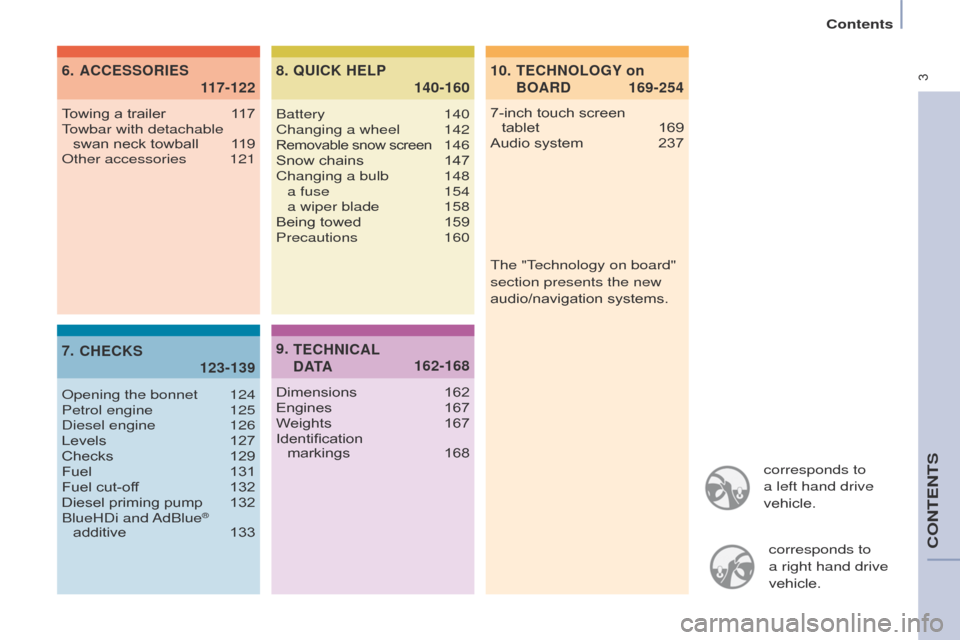
3
Contents
Berlingo-2-VU_en_Chap00a_Sommaire_ed02-2015
corresponds to
a left hand drive
vehicle.corresponds to
a
right hand drive
vehicle.
10.
169-254
TECHNOLOGY
on
BOARD
6.
1
17-122
ACCESSORIES
7.
123-139
CHECKS
8
.
140-160
QUICK HELP
7-inch touch screen
tablet 169
Audio system
237
T
owing a trailer
1
17
Towbar with detachable swan neck towball
1
19
o
ther accessories
121
o
pening the bonnet
124
Petrol engine
125d
iesel engine
126
Levels
127
Checks
129
Fuel
131
Fuel cut-of
f
132
Diesel priming pump
132
BlueH
d
i and
a
dBlue
®
additive
133 Battery
140
Changing a wheel
142Removable snow screen 146
Snow chains
147
Changing a bulb
148 a fuse
154 a wiper blade
158
Being towed
159
Precautions
160
9.
162-168
TECHNICAL
D ATA
Dimensions 162
Engines 167
W
eights
167
Identification
markings
168The "T
echnology on board"
section presents the new
audio/navigation systems.
CONTENTS
Page 14 of 260
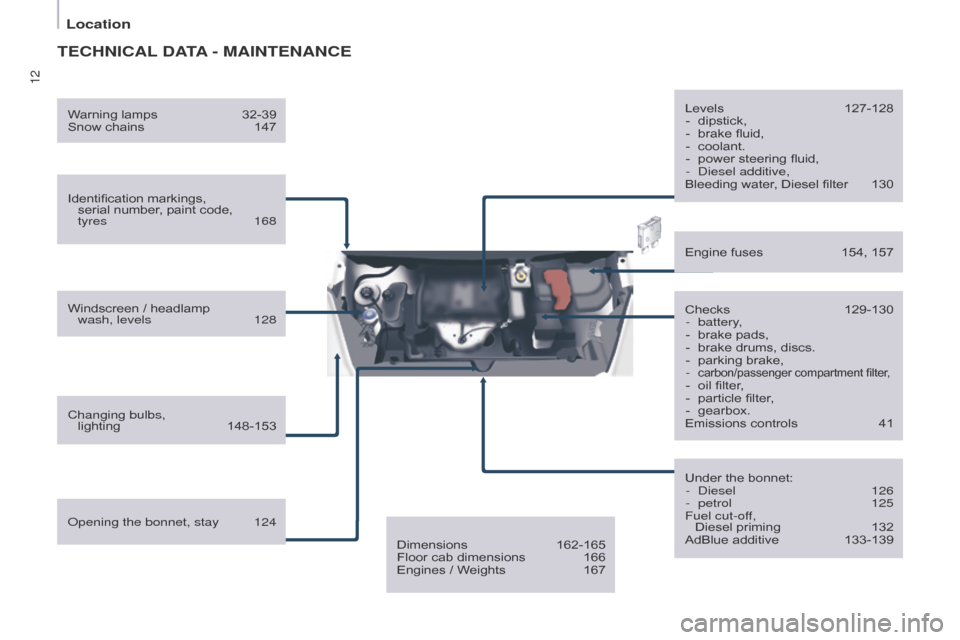
12
Location
Berlingo-2-VU_en_Chap01_vue-ensemble_ed02-2015
Berlingo-2-VU_en_Chap01_vue-ensemble_ed02-2015
TECHNICAL DATA - M AINTENANCE
Identification markings,
serial number, paint code,
tyres
168
Windscreen / headlamp wash, levels
128
Changing bulbs,
lighting
148-153 Checks
129-130
-
battery
,
-
brake pads,
-
brake drums, discs.
-
parking brake,
-
carbon/passenger compartment filter,- oil filter,
- particle filter ,
-
gearbox.
Emissions controls
41
Engine fuses
154, 157
Under the bonnet: -
d iesel
126
-
petrol
125
Fuel cut-of
f,
Diesel priming
132
AdBlue additive
133-139
o
pening the bonnet, stay
124 Levels
127-128
-
dipstick,
-
brake fluid,
-
coolant.
-
power steering fluid,
-
d iesel additive,
Bleeding water, Diesel filter
130
W
arning lamps
32-39
Snow chains
147
Dimensions
162-165
Floor cab dimensions
166
Engines / W
eights
167
Page 19 of 260
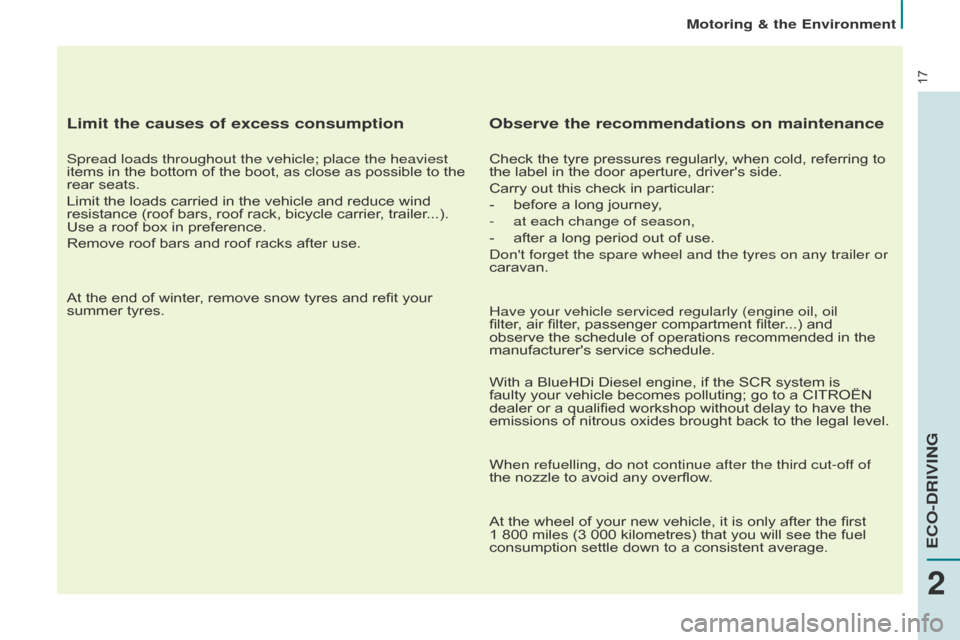
17
Motoring & the Environment
Berlingo-2-VU_en_Chap02_eco-conduite_ed02-2015
Limit the causes of excess consumption
Spread loads throughout the vehicle; place the heaviest
items in the bottom of the boot, as close as possible to the
rear seats.
Limit the loads carried in the vehicle and reduce wind
resistance (roof bars, roof rack, bicycle carrier, trailer...).
Use a roof box in preference.
Remove roof bars and roof racks after use.
At the end of winter, remove snow tyres and refit your
summer tyres.
Observe the recommendations on maintenance
Check the tyre pressures regularly, when cold, referring to
the label in the door aperture, driver's side.
Carry out this check in particular:
-
before a long journey
,
-
at each change of season,
-
after a long period out of use.
d
on't forget the spare wheel and the tyres on any trailer or
caravan.
Have your vehicle serviced regularly (engine oil, oil
filter, air filter, passenger compartment filter...) and
observe the schedule of operations recommended in the
manufacturer's service schedule.
With a BlueHDi Diesel engine, if the SCR system is
faulty your vehicle becomes polluting; go to a CITROËN
dealer or a qualified workshop without delay to have the
emissions of nitrous oxides brought back to the legal level.
When refuelling, do not continue after the third cut-off of
the nozzle to avoid any overflow.
At the wheel of your new vehicle, it is only after the first
1 800 miles (3 000 kilometres) that you will see the fuel
consumption settle down to a consistent average.
2
ECO-DRIVING
Page 22 of 260
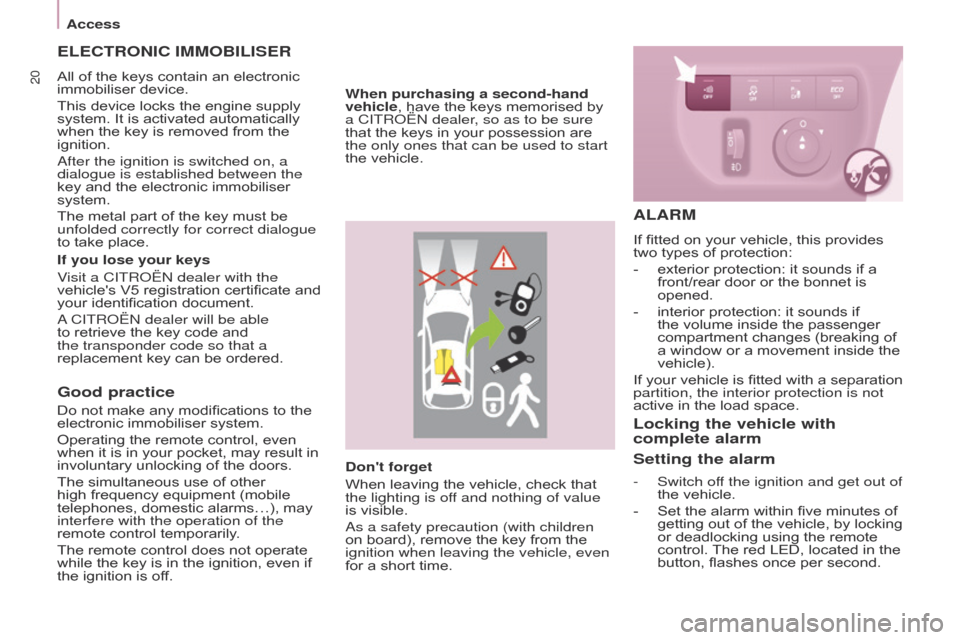
20
Access
Berlingo-2-VU_en_Chap03_Pret-a-partir_ed02-2015
Good practice
Do not make any modifications to the
electronic immobiliser system.
Operating the remote control, even
when it is in your pocket, may result in
involuntary unlocking of the doors.
The simultaneous use of other
high frequency equipment (mobile
telephones, domestic alarms…), may
interfere with the operation of the
remote control temporarily.
The remote control does not operate
while the key is in the ignition, even if
the ignition is off.
ELECTRONIC IMMOBILISER
All of the keys contain an electronic
immobiliser device.
This device locks the engine supply
system. It is activated automatically
when the key is removed from the
ignition.
a
fter the ignition is switched on, a
dialogue is established between the
key and the electronic immobiliser
system.
The metal part of the key must be
unfolded correctly for correct dialogue
to take place.
If you lose your keys
Visit a CITR
o Ë n dealer with the
vehicle's V5 registration certificate and
your identification document.
a CITR
o Ë n dealer will be able
to retrieve the key code and
the transponder code so that a
replacement key can be ordered.
Don't forget
When leaving the vehicle, check that
the lighting is off and nothing of value
is visible.
a
s a safety precaution (with children
on board), remove the key from the
ignition when leaving the vehicle, even
for a short time.
When purchasing a second-hand
vehicle, have the keys memorised by
a CITR
o Ë n dealer, so as to be sure
that the keys in your possession are
the only ones that can be used to start
the vehicle.
ALARM
If fitted on your vehicle, this provides
two types of protection:
-
exterior protection: it sounds if a
front/rear door or the bonnet is
opened.
-
interior protection: it sounds if
the volume inside the passenger
compartment changes (breaking of
a window or a movement inside the
vehicle).
If
your vehicle is fitted with a separation
partition, the interior protection is not
active in the load space.
Locking the vehicle with
complete alarm
Setting the alarm
- Switch of f the ignition and get out of
the vehicle.
-
Set the alarm within five minutes of
getting out of the vehicle, by locking
or deadlocking using the remote
control.
The red LED, located in the
button, flashes once per second.
Page 29 of 260
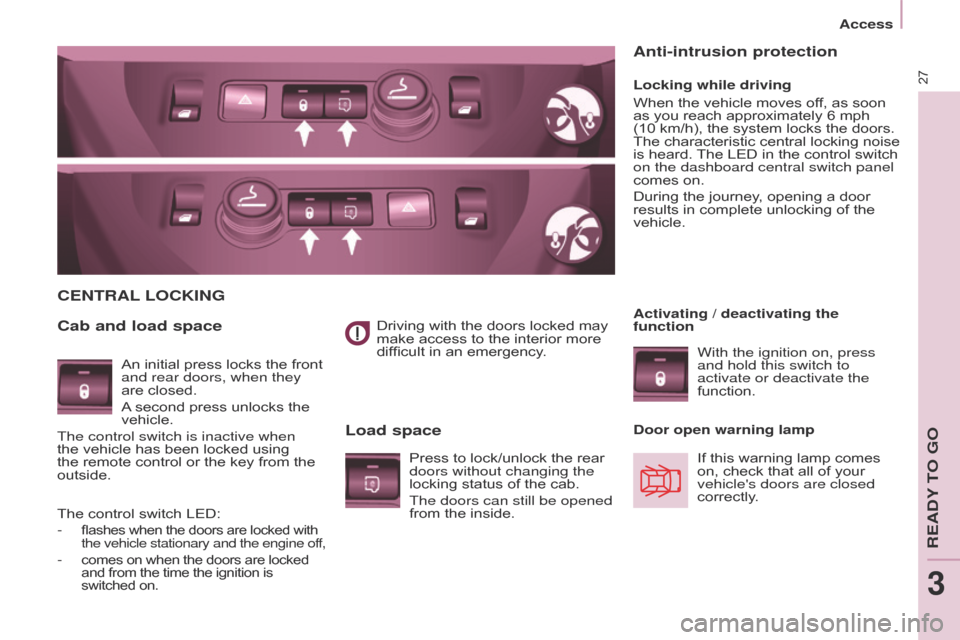
27
Access
Berlingo-2-VU_en_Chap03_Pret-a-partir_ed02-2015
Driving with the doors locked may
make access to the interior more
difficult in an emergency.
CENTRAL LOCKING
Cab and load space
Load space
Locking while driving
When the vehicle moves off, as soon
as you reach approximately 6 mph
(10 km/h), the system locks the doors.
The characteristic central locking noise
is heard. The LED in the control switch
on the dashboard central switch panel
comes on.
During the journey, opening a door
results in complete unlocking of the
vehicle.
Anti-intrusion protection
An initial press locks the front
and rear doors, when they
are closed.
A second press unlocks the
vehicle.
The control switch is inactive when
the vehicle has been locked using
the remote control or the key from the
outside. Activating / deactivating the
function
With the ignition on, press
and hold this switch to
activate or deactivate the
function.
Door open warning lamp If this warning lamp comes
on, check that all of your
vehicle's doors are closed
correctly.
Press to lock/unlock the rear
doors without changing the
locking status of the cab.
The doors can still be opened
from the inside.
The control switch LED:
-
flashes when the doors are locked with
the vehicle stationary and the engine off,
- comes on when the doors are locked
and from the time the ignition is
switched on.
READY TO GO
3
Page 34 of 260
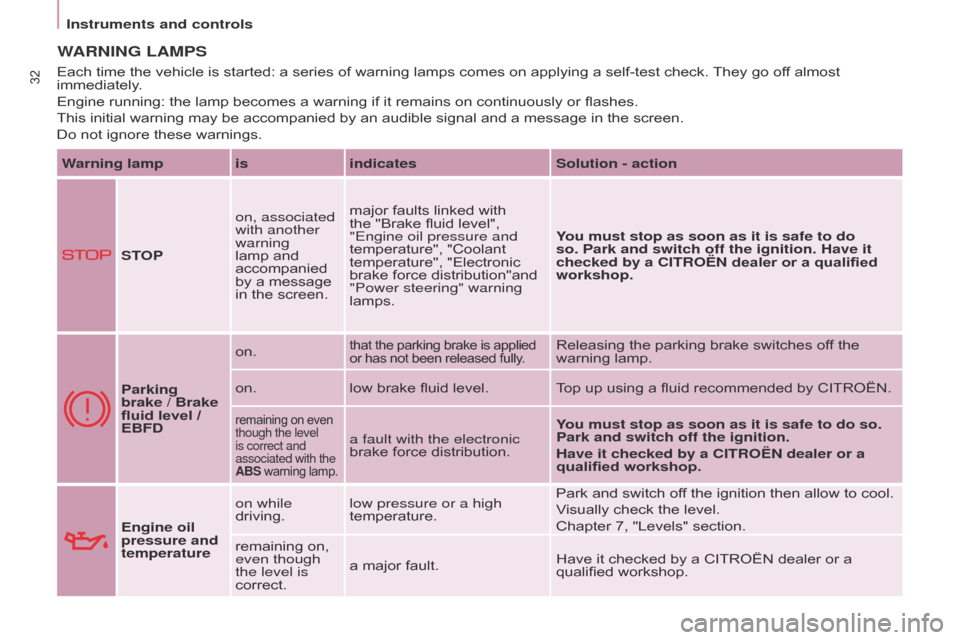
32
Berlingo-2-VU_en_Chap03_Pret-a-partir_ed02-2015
Instruments and controls
Berlingo-2-VU_en_Chap03_Pret-a-partir_ed02-2015
WARNING LAMPS
Warning lamp is indicatesSolution - action
STOP on, associated
with another
warning
lamp and
accompanied
by a message
in the screen. major faults linked with
the "Brake fluid level",
"Engine oil pressure and
temperature", "Coolant
temperature", "Electronic
brake force distribution"and
"Power steering" warning
lamps.
You must stop as soon as it is safe to do
so. Park and switch off the ignition. Have it
checked by a CITROËN dealer or a qualified
workshop.
Parking
brake
/ Brake
fluid level /
EBFD on.
that the parking brake is applied
or has not been released fully.Releasing the parking brake switches off the
warning lamp.
on. low brake fluid level. Top up using a fluid recommended by CITROËN.
remaining on even
though the level
is correct and
associated with the
ABS warning lamp.
a fault with the electronic
brake force distribution. You must stop as soon as it is safe to do so.
Park and switch off the ignition.
Have it checked by a CITROËN dealer or a
qualified workshop.
Engine oil
pressure and
temperature on while
driving.
low pressure or a high
temperature. Park and switch off the ignition then allow to cool.
Visually check the level.
Chapter 7, "Levels" section.
remaining on,
even though
the level is
correct. a major fault.
Have it checked by a CITROËN dealer or a
qualified workshop.
Each time the vehicle is started: a series of warning lamps comes on applying a self-test check. They go off almost
immediately.
Engine running: the lamp becomes a warning if it remains on continuously or flashes.
This initial warning may be accompanied by an audible signal and a message in the screen.
Do not ignore these warnings.
Page 35 of 260

33
Berlingo-2-VU_en_Chap03_Pret-a-partir_ed02-2015
Instruments and controls
Berlingo-2-VU_en_Chap03_Pret-a-partir_ed02-2015
Warning lamp isindicatesSolution - action
Coolant
temperature
and level on with needle
in the red
zone.
an abnormal increase in
temperature.
Park and switch off the ignition then allow to cool.
Visually check the level.
flashing. a drop in the coolant level. Chapter 7, "Levels" section.
Contact a CITROËN
dealer or a qualified
workshop.
Service on temporarily. minor faults or warnings.
Consult the alert log in the display or screen.
If your vehicle is equipped with a trip computer or
a screen: refer to the "Steering mounted controls"
section in Chapter 4.
Contact a CITROËN dealer or a qualified
workshop.
remaining on. major faults.
Seat belt not
fastened on then
flashing.
the driver and/or front
passenger has not fastened
their seat belt.
Pull the strap then insert the tongue in the buckle.
accompanied
by an audible
signal then
remains on. the vehicle is moving with
the driver's and/or front
passenger's seat belt not
fastened.
Check that the seat belt is fastened by pulling the
strap.
Chapter 5, "Seat belts" section.
ECO on.
The Stop & Start
system
has put the engine in
STOP mode following a
vehicle stop (red light, traffic
jam,
etc...).As soon as you want to move off, the warning
lamp goes off and the engine restarts
automatically in START mode.
flashes for a
few seconds,
then goes off. STOP mode is temporarily
unavailable.
or
START mode has been
invoked automatically.
Chapter 3, "Stop & Start" section.
READY TO GO
3
Page 36 of 260
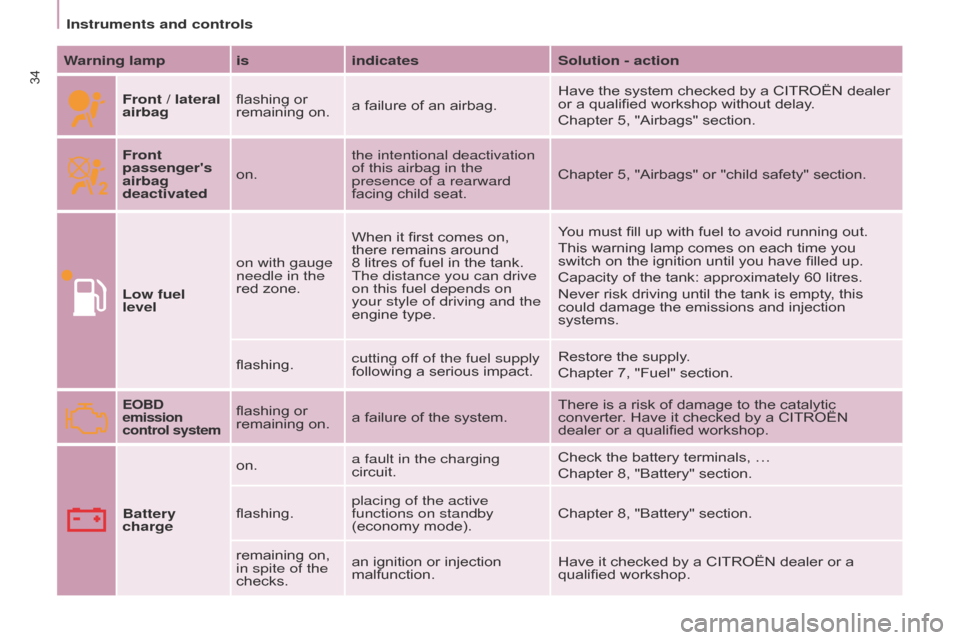
34
Berlingo-2-VU_en_Chap03_Pret-a-partir_ed02-2015
Instruments and controls
Berlingo-2-VU_en_Chap03_Pret-a-partir_ed02-2015
Warning lamp isindicatesSolution - action
Front / lateral
airbag flashing or
remaining on.
a failure of an airbag. Have the system checked by a CITROËN dealer
or a qualified workshop without delay.
Chapter 5, "Airbags" section.
Front
passenger's
airbag
deactivated on. the intentional deactivation
of this airbag in the
presence of a rearward
facing child seat. Chapter 5, "Airbags" or "child safety" section.
Low fuel
level on with gauge
needle in the
red zone. When it first comes on,
there remains around
8
litres of fuel in the tank.
The distance you can drive
on this fuel depends on
your style of driving and the
engine type. You must fill up with fuel to avoid running out.
This warning lamp comes on each time you
switch on the ignition until you have filled up.
Capacity of the tank: approximately 60 litres.
Never risk driving until the tank is empty, this
could damage the emissions and injection
systems.
flashing. cutting off of the fuel supply
following a serious impact. Restore the supply.
Chapter 7, "Fuel" section.
EOBD
emission
control systemflashing or
remaining on.
a failure of the system. There is a risk of damage to the catalytic
converter. Have it checked by a CITROËN
dealer or a qualified workshop.
Battery
charge on.
a fault in the charging
circuit. Check the battery terminals, …
Chapter 8, "Battery" section.
flashing. placing of the active
functions on standby
(economy mode). Chapter 8, "Battery" section.
remaining on,
in spite of the
checks. an ignition or injection
malfunction.
Have it checked by a CITROËN dealer or a
qualified workshop.
Page 42 of 260

40
Berlingo-2-VU_en_Chap03_Pret-a-partir_ed02-2015
Instruments and controls
Berlingo-2-VU_en_Chap03_Pret-a-partir_ed02-2015
FUEL GAUGEC OOLANT TEMPERATURE
The needle is positioned before the
red zone: normal operation.
In arduous conditions of use or hot
climatic conditions, the needle may
move close to the red graduations.What you should do if the needle
enters the red zone:
Reduce your speed or let the engine
run at idle.
What you should do if the warning
lamp comes on:
-
stop immediately
, switch off the
ignition. The fan may continue to
operate for a certain time, up to
approximately 10 minutes,
-
wait for the engine to cool down in
order to check the coolant level and
top it up if necessary
.
As the cooling system is pressurised,
follow the procedure below to avoid the
risk of scalding:
-
wait at least one hour after
switching of
f the engine before
carrying out any work,
-
unscrew the cap by 1/4 turn to
allow the pressure to drop,
-
when the pressure has dropped,
check the level in the header tank,
-
if necessary , remove the cap to top up.
If the needle remains in the red
zone, have the system checked by
a CITROËN dealer or a qualified
workshop.
Refer to chapter 7, "Levels"
section.
Refer to chapter 7, "Fuel" section.
The fuel level is tested each time the
key is turned to the "running" position.
The gauge is positioned on:
-
1:
the fuel tank is full,
approximately 60 litres.
-
0:
the reserve is now being used,
the warning lamp comes on
continuously. The reserve when
the warning first comes on is
approximately 8 litres.
Page 46 of 260
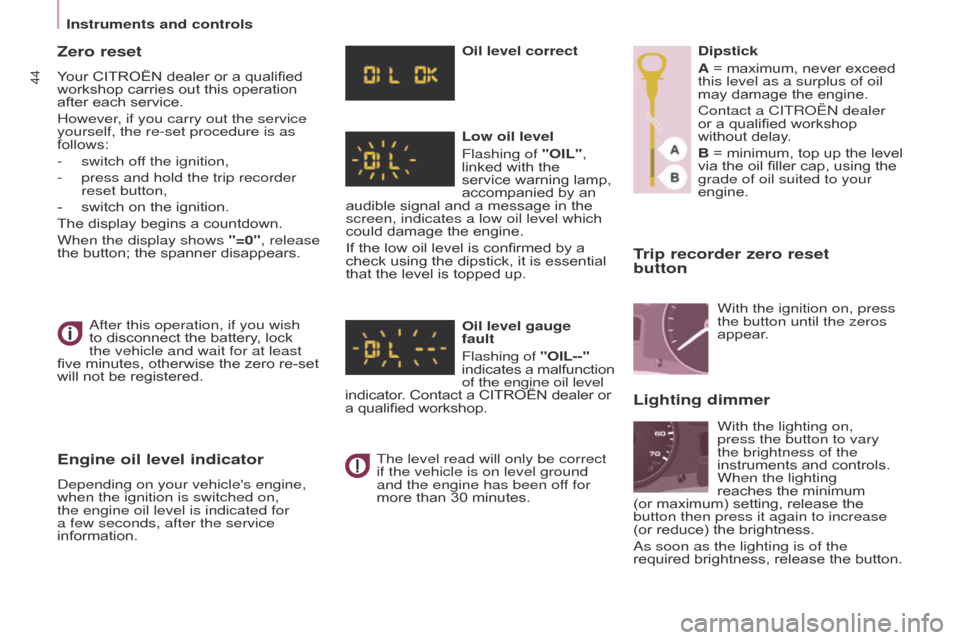
44
Berlingo-2-VU_en_Chap03_Pret-a-partir_ed02-2015
Instruments and controls
Berlingo-2-VU_en_Chap03_Pret-a-partir_ed02-2015
Trip recorder zero reset
button
after this operation, if you wish
to disconnect the battery , lock
the vehicle and wait for at least
five
minutes, otherwise the zero re-set
will not be registered.
Zero reset
Your CITROËN dealer or a qualified
workshop carries out this operation
after each service.
However, if you carry out the service
yourself, the re-set procedure is as
follows:
-
switch of
f the ignition,
-
press and hold the trip recorder
reset button,
-
switch on the ignition.
The display begins a countdown.
When the display shows
"=0", release
the button; the spanner disappears.
Engine oil level indicator
depending on your vehicle's engine,
when the ignition is switched on,
the engine oil level is indicated for
a few
seconds, after the service
information. Oil level correct
Low oil level
Flashing of "OIL",
linked with the
service warning lamp,
accompanied by an
audible signal and a message in the
screen, indicates a low oil level which
could damage the engine.
If the low oil level is confirmed by a
check using the dipstick, it is essential
that the level is topped up.
Oil level gauge
fault
Flashing of "OIL--"
indicates a malfunction
of the engine oil level
indicator. Contact a CITROËN dealer or
a qualified workshop.
The level read will only be correct
if the vehicle is on level ground
and the engine has been off for
more than 30 minutes. Dipstick
A = maximum, never exceed
this level as a surplus of oil
may damage the engine.
Contact a CITR
o Ë n dealer
or a qualified workshop
without delay.
B = minimum, top up the level
via the oil filler cap, using the
grade of oil suited to your
engine.
With the lighting on,
press the button to vary
the brightness of the
instruments and controls.
When the lighting
reaches the minimum
(or maximum) setting, release the
button then press it again to increase
(or
reduce) the brightness.
a
s soon as the lighting is of the
required brightness, release the button. With the ignition on, press
the button until the zeros
appear.
Lighting dimmer